No main menu side bar? Then click here to access the full site
Tatra T603
...a summary by Gareth Jones
The T603 project was begun in 1953, after the Czechoslovakian government issued the order for Tatra to design and build a car suitable for official duties, to replace the Volgas and ZILs that were used after production T87 ceased the previous year. The car would have six seats and an engine capacity of not more than 3.6 litres.
The heart of the new car was the newly developed 603 engine by Jiri Klos. A 2,545cc air-cooled V8, its specification was advanced; oversquare (75 x 72mm), with a single centre camshaft and hemispherical combustion chambers. The engine's first application was in the 4x4 T805, and in its 'military spec' it developed 75 bhp, but it had also been used in some interesting Tatra competition cars, like the T601 Tatraplan Montecarlo and the T602 and T607 sports racing cars. In the new T603 saloon, however, it produced 95 bhp at 5000 rpm.
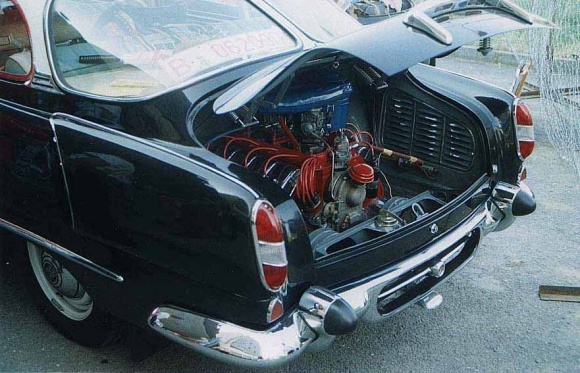
The bodyshell of the T603 was also advanced, compared with that of the T87, even though its streamlining and proportions were derived from the pre-war car. It had welded monocoque construction, with four doors, and seated three abreast in the front and rear. As with the T77, T87 and T600, the new T603 carried its engine behind the rear wheels, with a four-speed transaxle and swing axles. This was still an advanced suspension system at the time, used by Porsche on the 356 and Mercedes Benz on the Gullwing 300SL. The front suspension was unusual for the time, even though it seems more orthodox today, being a type of MacPherson strut suspension, with tall spring and damper units connected to the front inner wings. The lower links and anti-roll bar were well out of the way, giving a very large boot area despite the aerodynamic front of the car. Brakes were large finned drums all around, while the steering was rack and pinion, mounted on the front bulkhead with a central drop link. Tatra's chief engineer of at the time was Julius Mackerle, who had worked for Hans Ledwinka before WW2.
The bodyshell bucks were built in 1954, and the first running prototypes were ready in 1955. The six-light body design used curved glass for the front and rear screens, split at the rear to accommodate a T87-like fin that was contemplated very early in the project. The front of the car was no less dramatic, with three large headlights behind a curved glass panel, and a chrome-topped snout on the front bootlid. The clean, quality design of the interior included instrumentation housed under a hooded binnacle and a covered rear parcel shelf with a hinged cover. There were bench seats front and rear, with the front split to recline and the rear with a centre armrest. The car was first shown at the 1956 Brno Trade Fair, where its dramatic styling and engineering drew quite a lot of attention, and it was first shown to an international audience at the Cortina d'Ampezzo winter Olympics. The T603 was even shown in New York in 1960, but politics prevented it from being sold in western Europe.
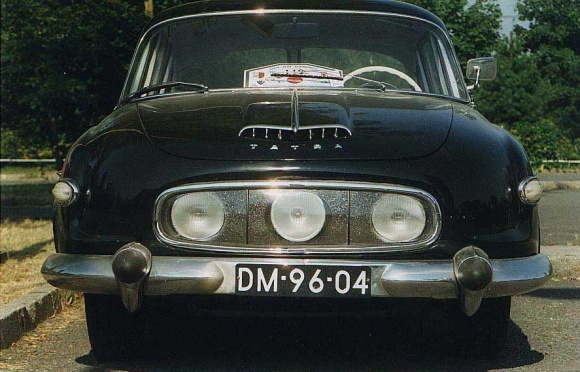
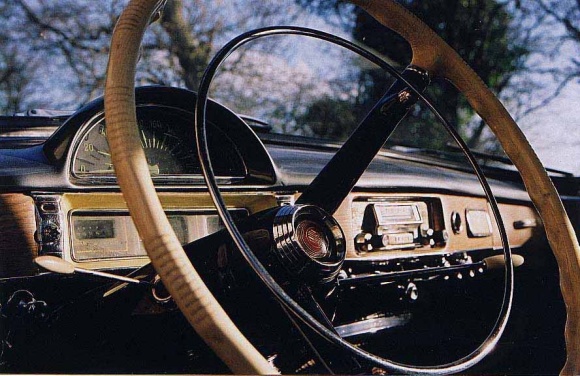
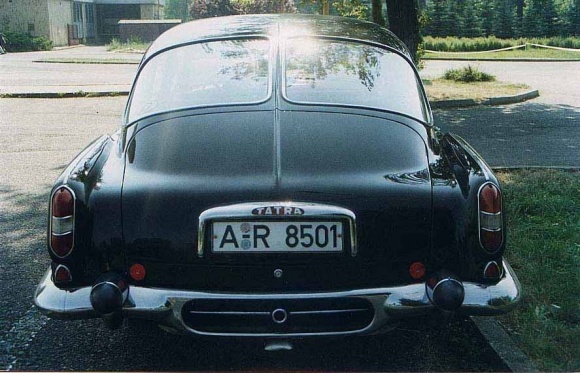
Tatra was well practiced in air-cooled engine production, and the T603 V8 was to be as advanced as possible for the time. Despite its smaller capacity than the three litre T87 engine, it produced more power, was cheaper to make and lighter. It used a single camshaft and short pushrods to operate two valves per cylinder in a hemispherical combustion chamber. There was a compact intake manifold on which were mounted two twin-barrel carburettors, and the exhaust manifold was a simple four-into-one arrangement. Cooling air was drawn in through the vents on the sides of the rear wings and through the oil coolers, then over the iron cylinders and aluminium heads. The air was pulled through by axial scavenge fans at the rear of the engine, powered by wide V-belts from the crankshaft pulley, which had a dog drive for a starting handle. When the engine was cold, a thermostatic bellows closed a flap which recirculated the air back through the engine compartment. When the engine was warm, the thermostat-controlled flap opened, allowing the air to exit through a slot in the rear bumper.
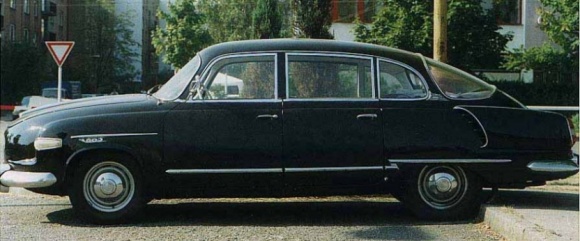
The 'Series 1' T603 (subsequently T1-603) was produced from 1956 to 1963, and for 1964 there was the imaginitively titled T2- 603. This brought improvements in power, now up to 100 bhp thanks to a higher compression ratio, but most noticeably changes in body styling. The characteristic three headlights under glass were replaced with four headlights in two groups of two in a fibreglass front panel, without the glass cover. The front doors had quarterlights, the rear numberplate cover was changed slightly and the rear wings, with their air scoops and tail lights, were reshaped. Inside the car, the fascia layout became simpler, the ivory coloured switches and steering wheel gave way to black, and the front bench acquired separate backrests and lost its stylish pressed steel framing.
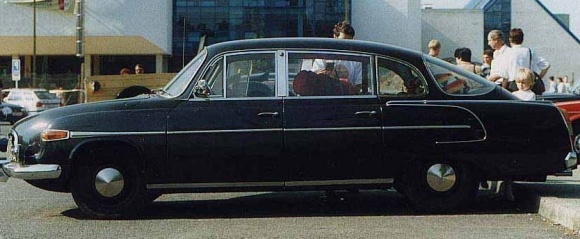
Gradual changes were made during the life of the T2-603, made more complicated for us now because cars were returned routinely to the factory for refurbishment, typically at seven year intervals. In 1967 Tatra reconfigured the car as the T3-603, although, to avoid further type approval costs, this designation was never officially applied. Brakes were given a vacuum servo to reduce pedal effort, and as the model continued into the late '60s, disc brakes were fitted. To improve reliability, the ignition system was changed from points and condensor to a capacitive discharge system, as used by various racing cars at the time. The front and rear track was widened on the T2-603 model, the independent heater was changed and its intake modified. Even the wiring harness was changed, leading to relocation of the fuses from the driver's side sill to the front bulkhead.

What Sort of 603?
An owner may be able to tell you when his car was made, but it will have been built over thirty years ago and probably been rebuilt more than once in the factory during its lifetime, so how is this possible? Are T603 owners blessed with some sort of inner vision that you aquire after running one for a while? No!
The first thing to remember is that the year the car was first made may have little to do with the way it is presented now. One club member owns a T1-603 that was given a new bodyshell by the factory in the late 1960s. When it was rebuilt into the new shell, many of the mechanical parts were probably renewed at the same time, so it is quite possible that the only part of the car dating from its first day in 1958 is the chassis plate, amended with a 1969 marking. Secondly, any T603 may have been modified after it left official service, and been updated by subsequent owners over the last twenty years. The third possibility is that some parts were changed when the car was rebuilt at the factory, leaving the main structure intact. The fourth, and much more unlikely scenario is that the car left the factory, was used for a while without being crashed or updated by officials or owners, and is still in its original state now. Assuming that you are looking at a third or fourth case car, where are the places to look?
T1-603 (1956-63) cars will have clipped chrome tail fins, small rear lights and a different shaped numberplate light. They will be the only ones with three headlights at the front, and front indicator lenses will be white. The fascia will have a semicircular speedometer in a binnacle raised from the dashboard top. First series T1-603s (see two-tone car with T805 above) have the chrome trim running in a straight line along the doors and rear wings, with spats over the rear wheels. From 1958 the chrome stepped upwards over the rear wheel, the wheelarch having a different shape. At this time there was also a chrome strip high up on the front wing (see black car side view above). The air intake on the front bonnet has a chrome surround and several vertical chrome strips.
T2-603 (1964-67) cars will keep the chrome running along the side as the late 603-1s but the front bonnet air intake lost its vertical strips. Also lost was the T A T R A chrome badging on the bonnet. Quarterlight windows were first seen on the 1964 cars and the headlights were changed to four set close together in two pairs. The interior was simplified and the speedometer was now of the strip type. The rear lights got larger and the rear numberplate light changed. The chrome rear fins got taller at the rear.
T3-603 (1968-75) cars only exist with this name to Tatra enthusiasts. The company never used the designation for the redesigned cars, and all official documents still refer to these late cars as T2-603s. The chrome strip along the side now ran in a continuous horizontal line from the front indicators. The lenses were now orange and there was no air intake in the front bonnet (look for a welded up panel on the left inner wing if the car used to have this type of bonnet). The headlight panel was wider and the pairs of headlights were spread further apart.
No main menu side bar? Then click here to access the full site